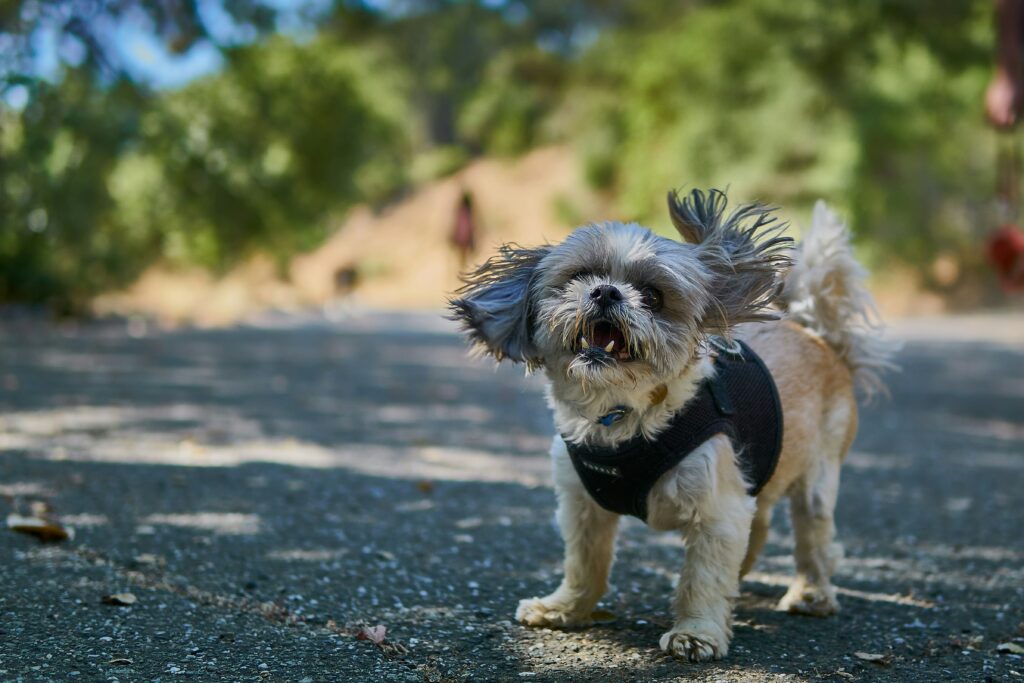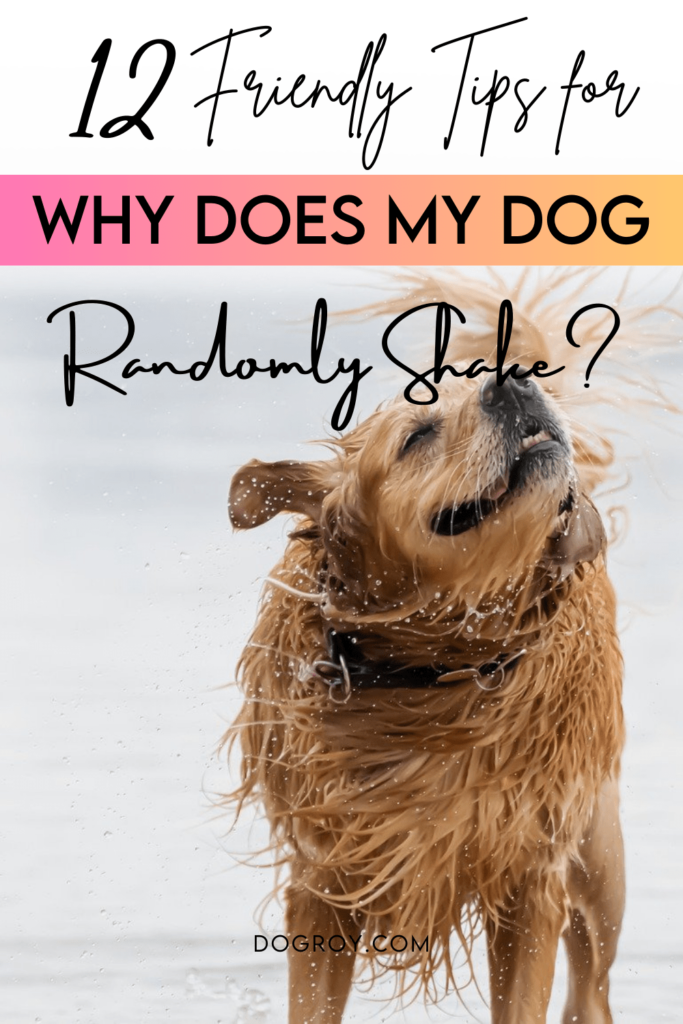The sight of our beloved canine companions shaking or trembling seemingly without reason can be a source of concern and curiosity for many pet owners.
If you’ve ever found yourself pondering the question, Why does my dog randomly shake? you’re certainly not alone.
Dogs exhibit a range of behaviors, and while the occasional shake may be completely normal, it’s essential to understand the potential reasons behind it.
In this comprehensive guide, we’ll delve into the intricacies of canine behavior, exploring 12 insightful tips to help unravel the mystery of why your dog may be shaking unexpectedly.
From possible health issues to behavioral considerations, these tips aim to provide a holistic understanding of your dog’s well-being.
Table of Contents
Understanding Your Pup: 12 Tips for Why Does My Dog Randomly Shake

1] Check for Chills: Could It Be a Response to Cold?
Just like humans, dogs might shake when feeling cold.
It’s essential to consider the ambient temperature and ensure your pup is warm and snug.
Offering a cozy blanket or adjusting the thermostat can contribute to your dog’s comfort.
Monitoring their environment and responding to temperature-related shivers showcases your attentiveness to their well-being.
Tip: “Consider your pup’s comfort in different temperatures to prevent shivers from chilly moments.”
2] Post-Bath Shivers: The Wet Pup Phenomenon
Post-bath shivering is a common occurrence in dogs and can be attributed to the sensation of being wet.
Ensuring a thorough drying process, perhaps with the use of a warm towel, not only addresses the shivers but also enhances your dog’s post-bath experience.
Offering a post-bath treat creates positive associations, turning this routine activity into a more enjoyable one for your furry friend.
3] Stress and Anxiety: Unraveling the Emotional Component
Dogs, like humans, may shake in response to stress or anxiety.
Identifying potential triggers, such as new environments, loud noises, or unfamiliar faces, allows you to create a calming space for your pup.
Reassurance through soothing words and gentle strokes can go a long way in alleviating anxiety-induced shakes, fostering a sense of security and trust.
Tip: “Understanding emotional needs helps your pup navigate stress, turning shakes into a dance of emotional release.”
4] Medical Check: Rule Out Underlying Health Issues
If your dog’s shaking appears unusual or excessive, consulting a veterinarian is crucial to rule out any underlying health issues.
Physical discomfort or pain could be a potential cause, and early detection ensures prompt and effective care.
Regular veterinary check-ups contribute to your dog’s overall well-being and provide peace of mind for you as a responsible pet owner.
5] Behavioral Conditioning: Positive Reinforcement
Implementing positive reinforcement techniques is an effective way to shape and encourage desired behaviors.
If your dog tends to shake excessively in specific situations, rewarding calm behavior with treats and praise creates a positive association.
This reinforcement helps your dog understand the desired response, gradually reducing unnecessary shaking.
6] Normal Dog Shaking: Embracing Quirky Traits
Dogs, with their endearing and sometimes quirky behaviors, may engage in random shaking as a completely normal expression.
This could be their way of communicating excitement, joy, or simply releasing excess energy.
Embracing these unique traits adds to the charm of your furry companion’s personality.
Instead of viewing their shakes as unusual, appreciate them with a smile as a delightful aspect of your dog’s individuality.
7] Massage and Comfort: A Bonding Experience
Engaging in gentle massages creates a bonding experience that is not only emotionally fulfilling but also physically beneficial for your dog.
Dogs often appreciate the soothing touch, and the relaxation induced by massage can alleviate stress, reducing the likelihood of random shakes.
Incorporating this comforting routine into your interaction strengthens the bond between you and your furry companion, promoting overall well-being.
Tip: “Soothing touches create relaxation, turning the shakes into a comforting dance of bonding.”
8] Excitement Overdrive: Happy Shakes
Excitement is a common trigger for doggy shakes, especially during playtime or in anticipation of a treat.
Acknowledging and celebrating these joyful shakes reinforces positive behaviors.
By encouraging your dog’s happiness and excitement, you contribute to a healthy emotional state and a vibrant, joyful companionship.
• Doggy shakes are triggered by excitement, especially during play or treat anticipation • Acknowledge and celebrate these joyful shakes to reinforce positive behaviors • Encouraging your dog's happiness contributes to a healthy emotional state • Fosters a vibrant, joyful companionship
9] Shake Off the Stress: Natural Stress Relief
In the wild, dogs instinctively shake to release tension and stress.
Your domesticated pup may retain this instinct, and allowing them to shake off stress after a challenging situation provides a natural and healthy outlet for emotional release.
Observing this behavior with understanding reinforces your role as a caring and attentive pet owner.
10] Ear Infections: Addressing Potential Discomfort
Checking your dog’s ears for signs of infection is essential if shaking seems persistent.
Redness, swelling, or a foul odor could indicate an ear issue causing discomfort.
Consulting your vet for a thorough examination and following their guidance on appropriate care ensures your dog’s ears remain healthy and pain-free.
Tip: “Ensure your dog’s ears are healthy, addressing any issues contributing to shaking.”
11] Environmental Changes: Adapting to New Surroundings
Dogs may shake when introduced to new environments due to a mix of excitement and uncertainty.
Gradual acclimation, coupled with reassurance and rewards for calm behavior, aids in building your dog’s confidence.
This proactive approach contributes to reducing shaking in novel situations, ensuring your dog feels secure and comfortable in different surroundings.
Tip: “Build confidence through gradual exposure, turning shakes in unfamiliar settings into a dance of adaptability.”
12] Allergy Awareness: Addressing Potential Triggers
Allergies can be a contributing factor to your dog’s shaking. Monitoring their surroundings and diet for potential allergens is essential.
Consultation with your vet helps identify and manage allergies effectively.
Addressing allergy-related shakes not only enhances your dog’s well-being but also underscores your commitment to their health and happiness.
Why Does My Dog Randomly Shake – FAQs
Is it normal for dogs to shake after a bath?
Yes, post-bath shivers are normal. Ensure your dog is thoroughly dried and offer positive reinforcement to create a positive association with bath time.
Can shaking be a sign of a serious health issue?
Excessive or unusual shaking could indicate an underlying health issue. Regular vet check-ups help identify and address potential concerns early.
How can I help my dog if they shake due to anxiety?
Create a calming environment, identify stress triggers, and use positive reinforcement techniques. Consult your vet for additional guidance on managing anxiety.
Can dogs shake when they’re happy?
Absolutely! Dogs often shake with excitement and joy. Celebrate their happy shakes as a reflection of their positive emotions.
One Dog Owner’s Perspective:
In a shared experience, a dog owner discovered that their pup’s random shaking was a result of excitement during playtime. Embracing the joyous shakes, the owner integrated positive reinforcement, turning playful moments into cherished bonding experiences.

Conclusion
Understanding why your dog randomly shakes involves a holistic approach that considers physical, emotional, and environmental factors.
By incorporating the 12 tips provided in this guide, you can embark on a journey of discovery and proactive care for your furry friend.
Remember that every dog is unique, and observing their behaviors with a compassionate and attentive eye will guide you towards providing the best possible support.
Embrace the bond you share with your canine companion, celebrate their well-being, and ensure a happy and healthy life together.





